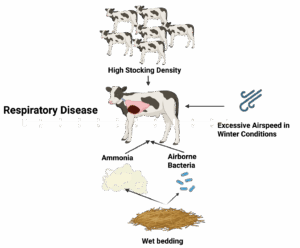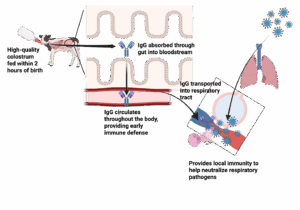Inleiding
Ademhalingsaandoeningen zijn een van de meest voorkomende en economisch belangrijkste gezondheidsproblemen bij voorgespeende melkkalveren. Het is verantwoordelijk voor een aanzienlijk deel van de antibioticabehandelingen, dierenartskosten en kalververliezen op boerderijen, en het blijft een hardnekkige belemmering voor het bereiken van een optimale gezondheid en productiviteit van kalveren.
Hoe gewoon is?
In een Canadees onderzoek met 74 melkveebedrijven en meer dan 7.800 kalveren werd bijna 30% van de kalveren ten minste één keer behandeld met een antibioticum tijdens de periode voor het spenen, en ademhalingsaandoeningen waren de meest genoemde reden voor behandeling. Het was goed voor 54% van alle geregistreerde antibioticabehandelingen (Uyama et al., 2022). Evenzo meldden gegevens van een Amerikaans onderzoek met meerdere staten onder meer dan 2500 kalveren dat een derde van de kalveren ten minste één gezondheidsgebeurtenis doormaakte, waarbij ademhalingssymptomen werden waargenomen bij 33% van de zieke kalveren. Van de kalveren met ademhalingsproblemen kregen 88% antibiotica. Dezelfde studie meldde een algehele sterfte vóór het spenen van 5% procent, waarbij ademhalingsaandoeningen verantwoordelijk waren voor 14% van de sterfgevallen en nog eens 7% met zowel ademhalings- als spijsverteringsoorzaken (Urie et al., 2018).
Wat is de impact?
Ziekten aan de luchtwegen tijdens de periode voor het spenen hebben ernstige gevolgen voor de prestaties van melkvaarzen en voor kalveren die worden opgefokt voor rund- of kalfsvlees.
Een recente meta-analyse evalueerde de impact van ademhalingsaandoeningen vóór het spenen op melkvaarzen aan de hand van gegevens uit 27 studies (Buczinski et al., 2021). Vaarzen waarbij een ademhalingsziekte werd vastgesteld tijdens de periode vóór het spenen, hadden een 3 keer hogere kans om te sterven en een 2 keer hogere kans om uit de kudde te worden verwijderd, hetzij door afslachting, verkoop of dood, vóór de eerste kalving in vergelijking met niet-aangetaste vaarzen. Deze vaarzen kwamen ook 67 gram per dag minder aan tijdens het voorspenen en produceerden 121 kilogram minder melk in hun eerste lactatie. Studies die deel uitmaakten van de meta-analyse vonden ook dat ademhalingsaandoeningen geassocieerd werden met een vertraging van 8 tot 14 dagen in de leeftijd bij het eerste afkalven en een lagere kans om de eerste lactatie te overleven. Samen illustreren deze bevindingen de impact van ademhalingsaandoeningen op jonge leeftijd op de productiviteit van de melkveestapel.
Bij kalveren die worden gefokt voor kalfsvlees of melkvee zijn de effecten ook aanzienlijk. In een onderzoek onder 3.519 vleeskalveren die tot aan de slacht werden gevolgd, werd een enkele episode van ademhalingsziekte in verband gebracht met een gemiddelde afname van 8 kilo van het warm geslacht gewicht, een lagere vetbedekking en een 6 keer hoger risico op sterfte in vergelijking met kalveren zonder ademhalingsziekte (Pardon et al., 2013). De impact verergerde bij herhaalde ziekte: kalveren die twee of drie of meer episodes van ademhalingsziekte doormaakten, hadden een gemiddelde afname in warm karkasgewicht van respectievelijk 22 en 42 kilogram. Meerdere episodes werden ook in verband gebracht met een slechtere karkaskwaliteit en een verhoogde kans op ongewenste roodvleeskleur bij het slachten.
Of kalveren nu bestemd zijn voor de melkveestapel of voor de vleesketen, de gevolgen van ademhalingsaandoeningen zijn aanzienlijk en onderstrepen het belang van gerichte preventie en een sterke basisimmuniteit om de gezondheid en prestaties van kalveren te beschermen.
Wat zijn de belangrijkste factoren bij preventie?
Huisvesting en milieu
De omgeving waarin kalveren worden grootgebracht heeft een directe invloed op hun gezondheid van de luchtwegen. Goed beheerde huisvesting kan de blootstelling aan ziekteverwekkers verminderen en de immuunfunctie ondersteunen, terwijl slechte omstandigheden het risico op ademhalingsaandoeningen kunnen verhogen door zowel directe als indirecte stressfactoren.
Bedding is een cruciaal onderdeel van de omgeving van het kalf. Omdat strooisel mest ophoopt en een diep, nat pak vormt, draagt het bij aan een hogere incidentie van ademhalingsaandoeningen bij pas gespeende kalveren (Donlon et al., 2023). Dit is waarschijnlijk te wijten aan zowel een verhoogde bacteriële belasting als de ophoping van ammoniak, een verontreinigende stof die ontstaat door de microbiële afbraak van ureum in verontreinigd strooisel en mest. Naast strooisel spelen ook andere aspecten van de stalomgeving een rol. Een goede ventilatie helpt bij het onder controle houden van vocht en verontreinigingen in de lucht, maar een te hoge luchtsnelheid wanneer het kalf zich buiten zijn thermoneutrale zone bevindt, kan leiden tot afkoeling en een toename van ademhalingsziekten (Donlon et al., 2023). Daarnaast is aangetoond dat het bieden van meer dan 35 vierkante meter per kalf de bacteriële concentraties in de lucht vermindert, waarschijnlijk door het verbeteren van de luchtstroom en het verminderen van de dierdichtheid (Norlund en Halbach, 2019). De invloed van deze factoren wordt samengevat in Figuur 1.

Figuur 1. Invloed van omgevings- en huisvestingsfactoren op de ontwikkeling van luchtwegaandoeningen bij kalveren.
Waar past colostrum bij?
Colostrum, of meer specifiek het bereiken van voldoende passieve immuniteit, staat niet altijd bovenaan de agenda bij het bespreken van de preventie van luchtwegaandoeningen. Het bewijs toont echter duidelijk aan dat het een centrale rol speelt bij het verminderen van het risico op longontsteking bij jonge kalveren.
Uit een recente samenvatting van acht onderzoeken naar longontsteking bij kalveren, waarvan de meeste gericht waren op melkveebeslagen, bleek dat kalveren met een slechte biestopname veel meer kans hadden op een ademhalingsziekte. Meer specifiek was het risico op ademhalingsziekte 1,6 keer hoger bij kalveren die geen passieve immuniteitsoverdracht hadden (Thompson en Smith, 2022). De auteurs schatten dat 31 procent van de gevallen van ademhalingsziekte bij kalveren met een mislukte overdracht van passieve immuniteit direct kan worden toegeschreven aan inadequaat colostrummanagement. In bredere zin was de mediaan van de toe te schrijven fractie 17 procent, wat betekent dat in een hele kudde bijna één op de zes gevallen van longontsteking zou kunnen worden voorkomen door de passieve immuniteit bij alle kalveren te verbeteren, niet alleen bij de kalveren met het hoogste risico.
Recent onderzoek heeft ook de waarde aangetoond van het bereiken van nog hogere niveaus van passieve immuniteit dan eerder werd gedacht. Uit een combinatie van de resultaten van drie onderzoeken met 10.000 melkvaarzen, gegroepeerd naar passieve immuniteit (Crannell en Abuelo, 2023; Lombard et al., 2020; Sutter et al., 2023), bleek dat behandeling voor ademhalingsaandoeningen voorkwam bij 25 procent van de kalveren met een slechte immuniteit, 18 procent met een redelijke, 13 procent met een goede en slechts 11 procent met een uitstekende passieve immuniteit. Deze bevindingen tonen aan dat het streven naar uitstekende (> 25 g IgG geabsorbeerd per L serum), niet alleen voldoende, colostrum overdracht kan een significant verschil maken in het voorkomen van ademhalingsaandoeningen.
Deze bescherming is waarschijnlijk te danken aan immunoglobuline G, het dominante antilichaam in colostrum. Zodra IgG is opgenomen, circuleert het in het bloed, neutraliseert het ziekteverwekkers en ondersteunt het de vroege immuunrespons. Naast de systemische rol kan IgG ook terug worden getransporteerd naar mucosale oppervlakken, waaronder de luchtwegen, waar het pathogenen helpt blokkeren op de plaats van infectie. Figuur 2 laat zien hoe IgG beschermt tegen luchtwegaandoeningen. Colostrum bevat ook andere immuunondersteunende bestanddelen, zoals lactoferrine, cytokinen en groeifactoren, die de vroege immuunontwikkeling en weerbaarheid tegen ziekten verder verbeteren.

Figuur 2. Pathway of how colostrum supports the prevention of respiratory disease.
Boodschappen mee naar huis nemen
Het voorkomen van ademhalingsaandoeningen bij kalveren vereist aandacht voor zowel de omgeving als de verzorging op jonge leeftijd. Schoon, droog strooisel, goede ventilatie en voldoende ruimte helpen de blootstelling aan ziekteverwekkers in de lucht te verminderen. Net zo belangrijk is het om kalveren kort na de geboorte biest van hoge kwaliteit te geven, zodat ze de bescherming krijgen die ze nodig hebben om gezond te blijven. Samen verlagen deze praktijken het ziekterisico, verminderen ze de behoefte aan behandeling en ondersteunen ze betere resultaten op lange termijn.
Dave Renaud DVM PhD, universitair hoofddocent, Universiteit van Guelph
Referenties
Buczinski S, Achard D, Timsit E. Effects of calfhood respiratory disease on health and performance of dairy cattle: Een systematisch overzicht en meta-analyse. Journal of Dairy Science. 2021 Jul 1;104(7):8214-27.
Crannell P, Abuelo A. Vergelijking van morbiditeit, mortaliteit en toekomstige prestaties van kalveren tussen verschillende categorieën van passieve immuniteit: Een retrospectieve cohortstudie in een melkveestapel. Tijdschrift voor Zuivelkunde. 2023 Apr 1;106(4):2729-38.
Donlon JD, McAloon CG, Hyde R, Aly S, Pardon B, Mee JF. A systematic review of the relationship between housing environmental factors and bovine respiratory disease in preweaned calves-Part 2: Temperature, relative humidity and bedding. The Veterinary Journal. 2023 Oct 1;300:106032.
Lombard J, Urie N, Garry F, Godden S, Quigley J, Earleywine T, McGuirk S, Moore D, Branan M, Chamorro M, Smith G. Consensusaanbevelingen voor passieve immuniteit bij melkkalveren op kalfs- en kuddeniveau in de Verenigde Staten. Tijdschrift voor zuivelwetenschap. 2020 Aug 1;103(8):7611-24.
Nordlund KV, Halbach CE. Het ontwerp van kalverstallen om de gezondheid en het management te optimaliseren. Veterinaire klinieken: Food Animal Practice. 2019 Mar 1;35(1):29-45.
Pardon B, Hostens M, Duchateau L, Dewulf J, De Bleecker K, Deprez P. Impact van ademhalingsziekte, diarree, otitis en artritis op sterfte en karkaskenmerken bij blankvleeskalveren. BMC Veterinair Onderzoek. 2013 Dec;9:1-4.
Raboisson D, Trillat P, Cahuzac C. Falen van passieve immuunoverdracht bij kalveren: Een meta-analyse van de gevolgen en beoordeling van de economische impact. PloS one. 2016 Mar 17;11(3):e0150452.
Sutter F, Venjakob PL, Heuwieser W, Borchardt S. Association between transfer of passive immunity, health, and performance of female dairy calves from birth to weaning. Tijdschrift voor Zuivelkunde. 2023 Oct 1;106(10):7043-55.
Thompson AC, Smith DR. Failed transfer of passive immunity is a component cause of pre-weaning disease in beef and dairy calves: Een systematische review en meta-analyse. The Bovine Practitioner. 2022 Dec 29;56(2):47-61.
Urie NJ, Lombard JE, Shivley CB, Kopral CA, Adams AE, Earleywine TJ, Olson JD, Garry FB. Preweaned heifer management on US dairy operations: Part V. Factors associated with morbidity and mortality in preweaned dairy heifer calves. Tijdschrift voor Zuivelkunde. 2018 Oct 1;101(10):9229-44.
Uyama T, Renaud DL, Morrison EI, McClure JT, LeBlanc SJ, Winder CB, de Jong E, McCubbin KD, Barkema HW, Dufour S, Sanchez J. Associations of calf management practices with antimicrobial use in Canadian dairy calves. Journal of Dairy Science. 2022 Nov 1;105(11):9084-97.
